Freshwater Aquarium Algae Guide
Posted by Miles Harrison on 01/12/2022
December's Giveaways on Light Fish
Introduction
Most algae problems in freshwater tanks can be attributed to a small set of variables.
- Gaseous Exchange and Oxygen
- Light Intensity
- Nutrient Demand
- Carbon Dioxide Deficiency
Finding the perfect balance of these variables will inhibit the growth of unwanted algae. In this post, we'll discuss some of the most common types of algae, and suggest some solutions for their removal.
This post assumes you have some basic knowledge of freshwater nutrient dosing.
Black Beard Algae
Extremely common in CO2 injected freshwater tanks. Black Beard Algae can be difficult to eradicate.
Cause
Black Beard Algae flourishes when CO2 levels are unstable, flow is low, and there is a limited amount of gaseous exchange.
Recommendation
Increase CO2 levels, check to make sure there is enough water flow and surface agitation. You'll want to aim for a gentle ripple on the surface while making sure there is enough flow where you can visibly see your plant sway.
Removal
Overdosing or spot treating the algae with Flourish Excel should kill it. A 3-day tank blackout will also help weaken this algae.
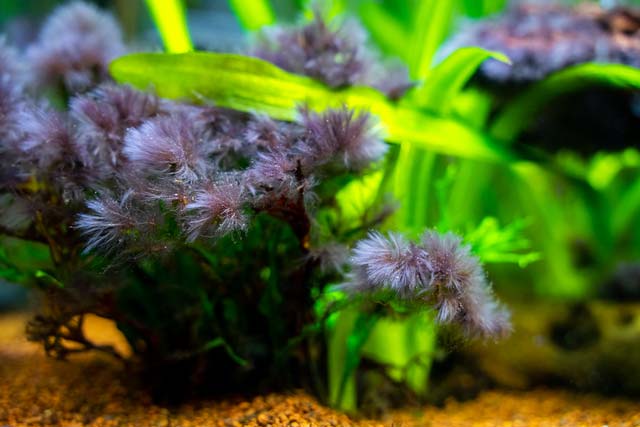
Black Beard Algae
Known for its small black tufts, this algae grows frequently on slow-growing plants and hardscape
Blue Green Algae
Blue Green Algae often occurs when nitrates are low. It usually grows on the tank glass or substrate. Occasionally it will cover plants.
Cause
Blue Green Algae appears when nitrates are low and flow is almost non-existent.
Recommendation
Increase nitrate dosing. Double-check your dosing strategy to ensure nitrate levels are within the correct range for KNO3. If you're new to dosing strategies, we recommend checking out this post to learn the fundamentals.
Removal
Remove as much as you can with an algae scraper. A 3-day tank blackout will also help weaken this algae.
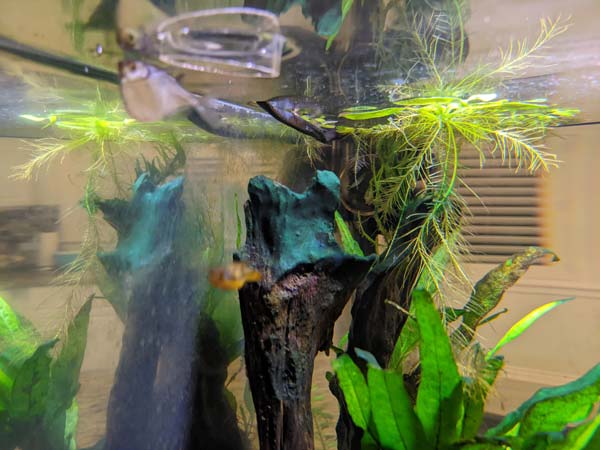
Blue Green Algae
Known for its slime-like texture, this algae peels off easily.
Image courtesy of Reddit user u/vitzaa
Diatoms (or Brown Hair / Brown Dust Algae)
Diatoms are commonly seen when setting up a new tank, and tend to disappear on their own after a tank is fully cycled.
Cause
Diatoms often appear when cycling a new tank, but can also appear if there are not enough nutrients.
Recommendation
Dose recommended levels of KNO3 and KH2PO4 based on your tank size. If your tank is newly set up, allow the tank to finish cycling (about 1 month.) Most likely, the diatoms will disappear on their own.
Removal
If the diatoms don't disappear after your tank has finished cycling, or your tank has been cycled, you can remove as much as you can with an algae scraper. A 3-day tank blackout (cover your tank with blankets, ensure no light is getting through) should also help.
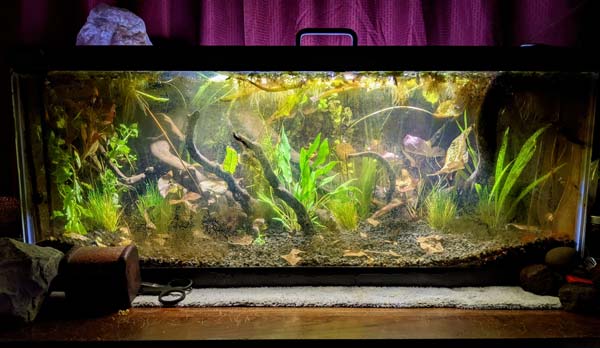
Diatoms
Diatoms often appear as brown dust on the aquarium glass or as brown thread. In this image, we can see the algae in the form of brown dust.
Image courtesy of Reddit user u/cshimii
Green Dust Algae
Green Dust Algae is a common and difficult to remove algae that appears in mature, high-light planted tanks.
Cause
Green Dust Algae appears when nitrates are low, water flow is low, and CO2 levels are inconsistent.
Recommendation
Slowly increase CO2 levels while monitoring fish for signs of stress. Confirm you're dosing the correct amount of nutrients. Ensure there is a good amount of flow moving around your tank. You want a ripple on the surface, and enough flow to provide a gentle sway to your plants.
Removal
Scrape off as much as you can with an algae scraper. Perform a large water change (50%), adjust CO2 levels as necessary. Repeat these steps until the dust algae has been eradicated.

Green Dust Algae
Green Dust Algae often appear as green dust on the aquarium glass.
Hair Algae
Common algae that occurs in tanks with nutrient deficiency. Once established, this algae can grow quickly in a planted tank where nutrients are being dosed.
Cause
Hair Algae is usually tied to a nutrient deficiency, and can sometimes be seen in new tank setups.
Recommendation
Increase KNO3/KH2PO4 dosing. Double-check your dosing strategy to ensure you're dosing the correct amount of nutrients while providing sufficient amounts of CO2.
Removal
Hair Algae can be difficult to remove. If it's manageable, you can use a toothbrush to gather and remove the strands. A large water change combined with a 3-day tank blackout will be very effective in removing this algae.

Hair Algae
Hair Algae often appear as long green strands.
Green Spot Algae
Often appearing in CO2 injected tanks where there is a nutrient deficiency, Green Spot Algae is difficult to remove and can cover your aquarium glass.
Cause
Green Spot Algae is attributed to low phosphate levels, fluctuating CO2, and poor waterflow.
Recommendation
Increase KH2PO4. Increase CO2. Check for 'dead-zones' where there is limited flow in your tank. You'll want to establish stable CO2 levels to get rid of this algae.
Removal
Green Spot Algae is difficult to remove since it cannot easily be scraped off with an Algae Scraper. Large water changes combined with multiple blackouts will help weaken this algae. Green Spot Algae tends to disappear slowly on its own once the tank parameters have stabilized.
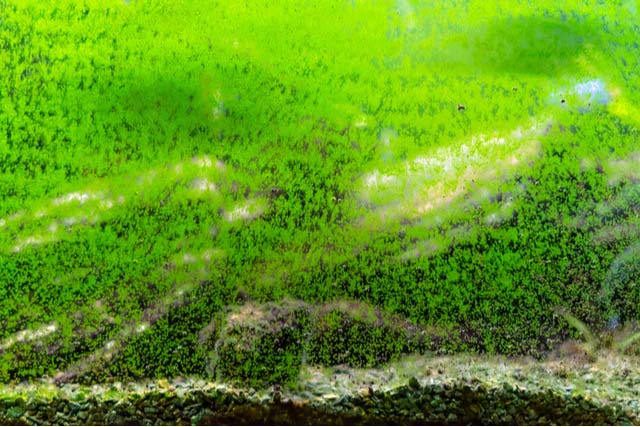
Green Spot Algae
Green Spot Algae appears as dark-green spots that are not easily removable.
Green Water
Green water can make your tank look as if it's turned into a green smoothie. It's very unsightly and often indicates a lack of overall care.
Cause
Skipping water changes combined with a nutrient deficiency can cause this algae to spread.
Recommendation
Keep up with weekly water changes and ensure nutrient levels are sufficient.
Removal
Perform large water changes every 2-3 days until the tank water begins to clear up.

Green Water
Green water can be removed easily with water changes.
Staghorn Algae
Low CO2 and insufficient flow can cause a Staghorn outbreak.
Cause
CO2 levels and flow are the number one cause for Staghorn Algae outbreaks.
Recommendation
Increase CO2 levels. Increase water flow throughout the tank.
Removal
Spot treat with Flourish Excel. Staghorn will tend to die off once water parameters have stabilized.
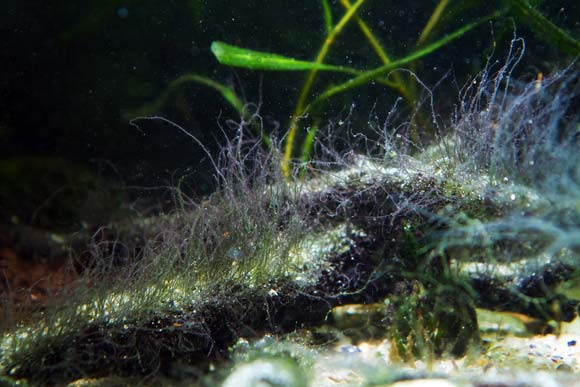
Staghorn Algae
Staghorn Algae often appear as short, gray strands that grow on hardscape.
Conclusion
If there's one common theme, it's that algae issues often stem from a combination of the 4 variables mentioned at the beginning of this blog post. Gaseous exchange, CO2 imbalance, light intensity, and nutrient deficiency. Making the necessary adjustments to these parameters will ensure your freshwater tank remains healthy, and algae-free!
Additional Resources
Dennis Wong is a YouTuber and Planted Tank expert. We love his video Optimizing CO2 in a planted tank, which outlines the importance of gaseous exchange and balanced CO2 levels.
Optimizing CO2 in a planted tank
By Dennis Wong
Thanks for reading!
December's Giveaways on Light Fish

